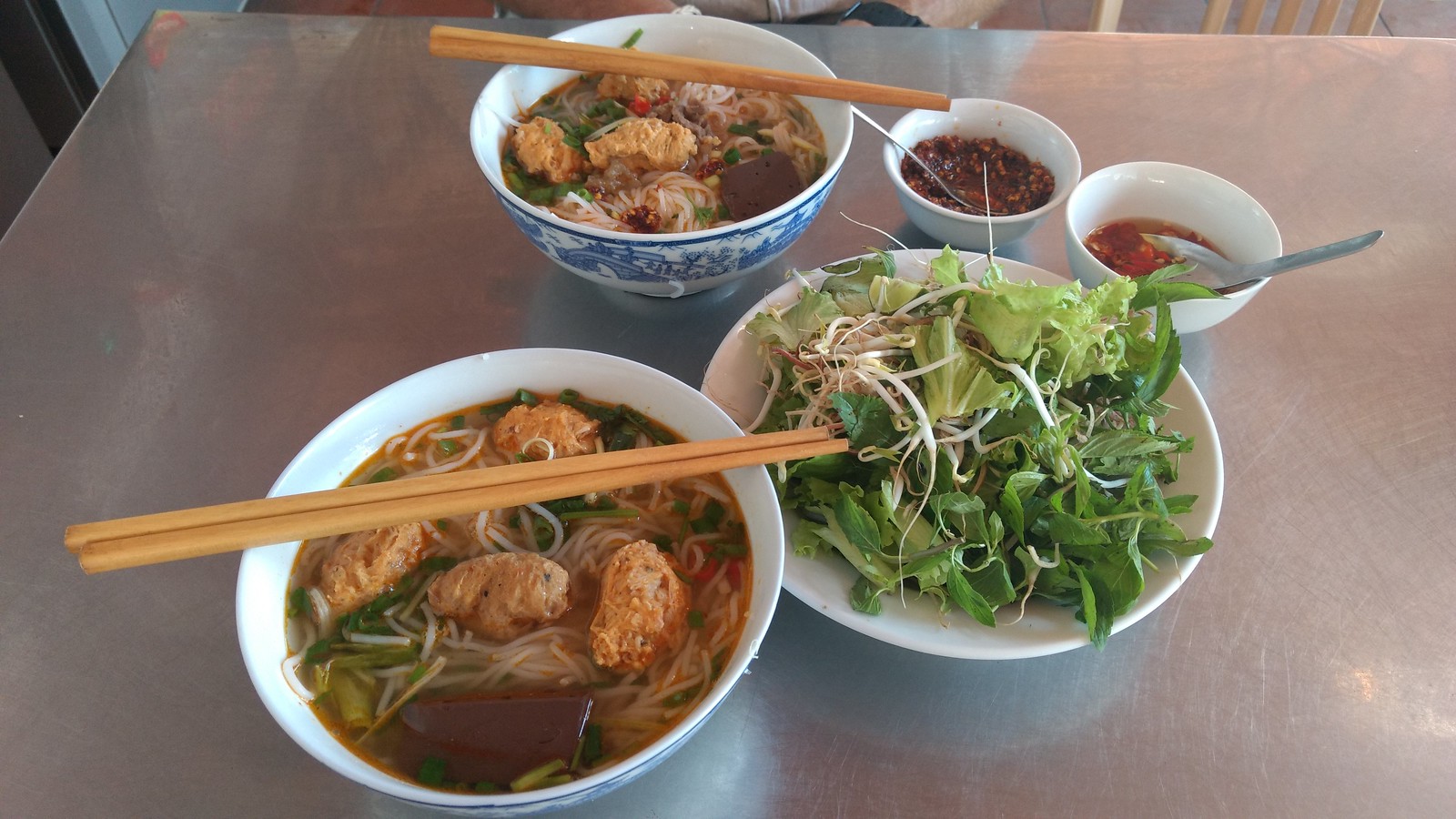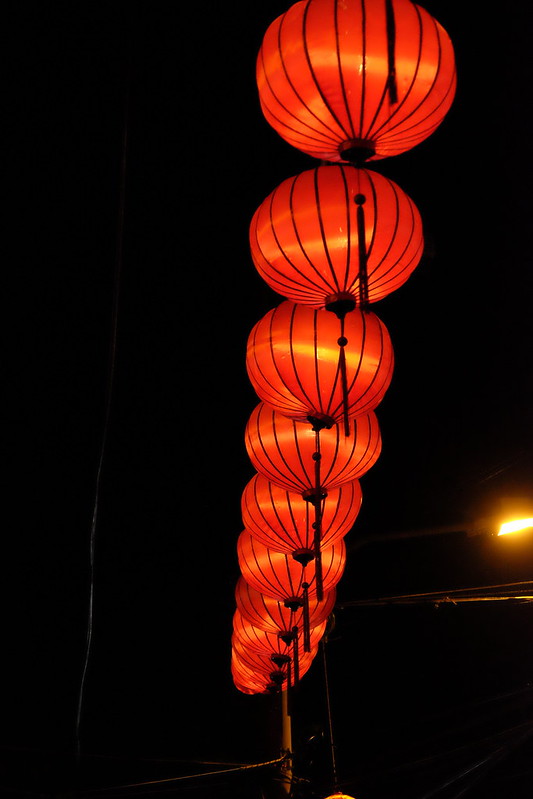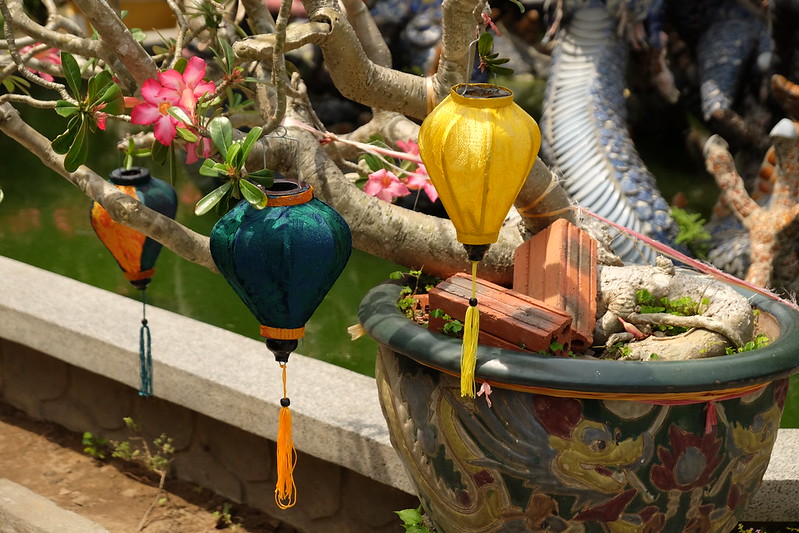A note before we begin: apparently our earlier post called “A Taste of Malaysia” went to several spam folders, including mine. If you didn’t get it, it contained the date we’re coming home, which is coming right up on June 3!
We decided to save the Mekong Delta for a future trip because we wanted to have enough time to visit a few towns in the center before heading north. So, from Saigon we went to Hoi An.
Hoi An was a real pleasure to visit, a touristy but unique city due its very well preserved old town with its beautiful Chinese-style lanterns hanging everywhere, which made it especially picturesque to walk around in the evening. Hoi An was a major trading port city starting from the 15th century and its prominence lasted until there was a change in power, and the river estuary on which it sat silted up, at the end of the 18th century. Most of the structures in the old town were built by the Chinese, but there are also a few others, one of which is a covered Japanese bridge that was originally built in the early 1600s. Today, all the Chinese shophouses have been turned into restaurants and shops, so the community’s culture is completely gone, but some shophouses have been left as they were and are open to visit, as are community halls and temples of the different Chinese clans that lived there. The town was also historically famous for its textiles, and today that has transformed into tailoring. There are hundreds of tailor shops that will crank out a suit in a day or so for very little money.
 A bridge in the old town at night.
A bridge in the old town at night.
 Typical street in the old town.
Typical street in the old town.
Hoi An is also known for, what else, its delicious regional food, so we took another cooking class. The cooking class started with the typical walk through the local market, and was followed by a boat ride down the river to the place where the class was held in a beautiful outdoor setting, away from the bustle of the town. We were the only participants that day so we cooked everything, and made and ate some really fantastic food. Our very favorite was the Bo La Lot, which is minced beef mixed with shallots, lemongrass, etc., wrapped in locally grown piper lolot leaves and grilled. I aim to hunt down some of these leaves in the Asian markets in Seattle so we can make it at home. We also enjoyed a cup of well made Vietnamese coffee. Vietnam has exploded onto the coffee scene, becoming the second largest producer in the world behind only Brazil, so we naturally wanted to compare it to some of the other places we’ve been that produce the black gold. With so many coffee houses littering the city, it was easy to sample. We preferred the local method of imbibing, which was made using special individual metal filters dripping into your cup over a layer of sweetened condensed milk. Vietnam produces more Robusta than Arabica coffee beans, and most of the coffee we were served was either Robusta or a blend, which made it more highly caffeinated and much more strongly flavored than we’re used to. The sweetened condensed milk went very well with it, and for me at least, was necessary.
 In the market. Many people wore the conical hats in Vietnam.
In the market. Many people wore the conical hats in Vietnam.
 On the way to our class, which was held by the covered docks ahead.
On the way to our class, which was held by the covered docks ahead.
To us, two of the top land-based experiences in Southeast Asia are eating and exploring. So as usual, we rented a scooter in Hoi An and took a few rides around the area where the rice harvest was in full swing. The rice was being harvested by machine, and the fields were being burnt afterward when they were dry enough. Rice was being dried on every large flat surface around, including the major roads. It’s a wonder we didn’t find any rocks in our rice!
 Dried rice fields after the harvest. Some are burning in the background.
Dried rice fields after the harvest. Some are burning in the background.
 As she pours the rice, the dried husks blow off. This is happening on a sidewalk of a major road.
As she pours the rice, the dried husks blow off. This is happening on a sidewalk of a major road.
When we’d seen and eaten enough of Hoi An, we took the train north to Hue (pronounced “WHEY” as in oats and whey), the Imperial capital of Vietnam. We only spent a few days there and didn’t like it as much as Hoi An, but it’s worth visiting, especially if you aren’t burned out like we are right now. Hue is the former Imperial capital of Vietnam. It contains a formidable Citadel, which can be toured for a price, and several tombs of the Nguyen dynasty emperors. The Citadel also had a prominent place in the Vietnam War. As part of the Tet Offensive, the North Vietnamese Army and the Viet Cong attacked and took control over a good portion of the city of Hue, including parts of the Citadel. The South Vietnamese Army held onto other parts of the Citadel, and the Americans eventually destroyed most of the structures within it as a means of saving it, ironically. Being burned out on sights and knowing we wouldn’t appreciate it right now, we didn’t go into the Citadel but just drove around it, which was impressive in and of itself. We also skipped the most popular tombs and their tourists, and instead drove our scooter down to the farthest away, least visited, and oldest tomb, that of the first Nguyen emperor named Gia Long, built from 1814 – 1820. Gia Long was also the emperor who built the Citadel and original palace within it, although several emperors added to the construction afterward. We had the tomb complex to ourselves, so it was great – peaceful as a tomb should be. It is a complex of several buildings in a gorgeous and remote countryside setting with a large lotus pond in front. It was just what we were in the mood for.
 One of the buildings in the tomb complex.
One of the buildings in the tomb complex.
 The lotus pond in front of the tomb complex.
The lotus pond in front of the tomb complex.
We can’t end a post about Hue without saying a word about what is reputed to be one of the best soups in the world, Bun Bo Hue, which translated means “Hue style beef noodle soup.” It’s a relatively spicy soup made of pork and beef broth, with thin vermicelli noodles, some sort of meatballs, and cubes of congealed pork blood in it, topped with the fresh herbs of Vietnam. We tried it at a few places and it was quite good, but the prizes for our favorite noodle bowl dishes from Vietnam would go to Mi Quang and Cao Lau, both from Hoi An, neither of which we’ve ever seen on a Vietnamese restaurant menu at home. But, that’s what cooking classes are really for: the recipes! Plus, I bought a cookbook written by a locally famous restaurateur that isn’t available on Amazon 🙂
 The best bowl of the famous Bun Bo Hue that we had.
The best bowl of the famous Bun Bo Hue that we had.
Here are more pictures from Hoi An and Hue:
































4 replies